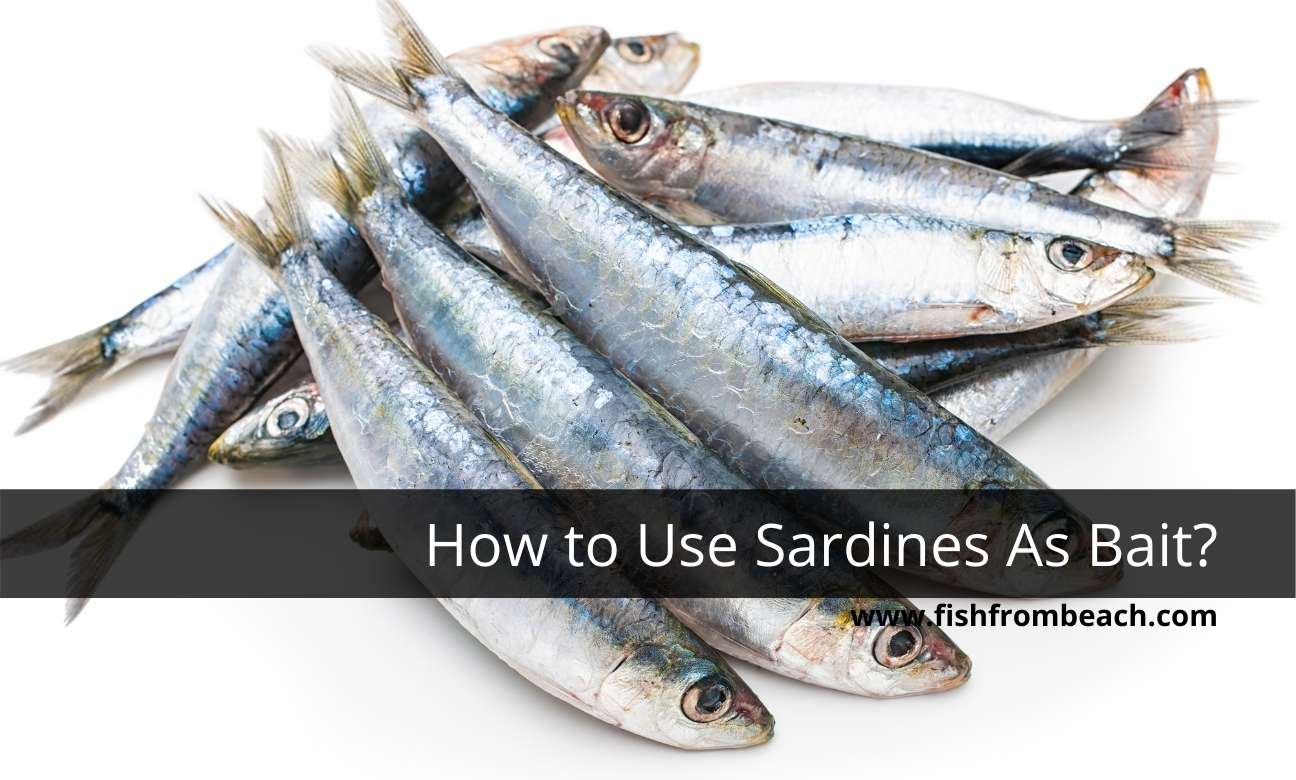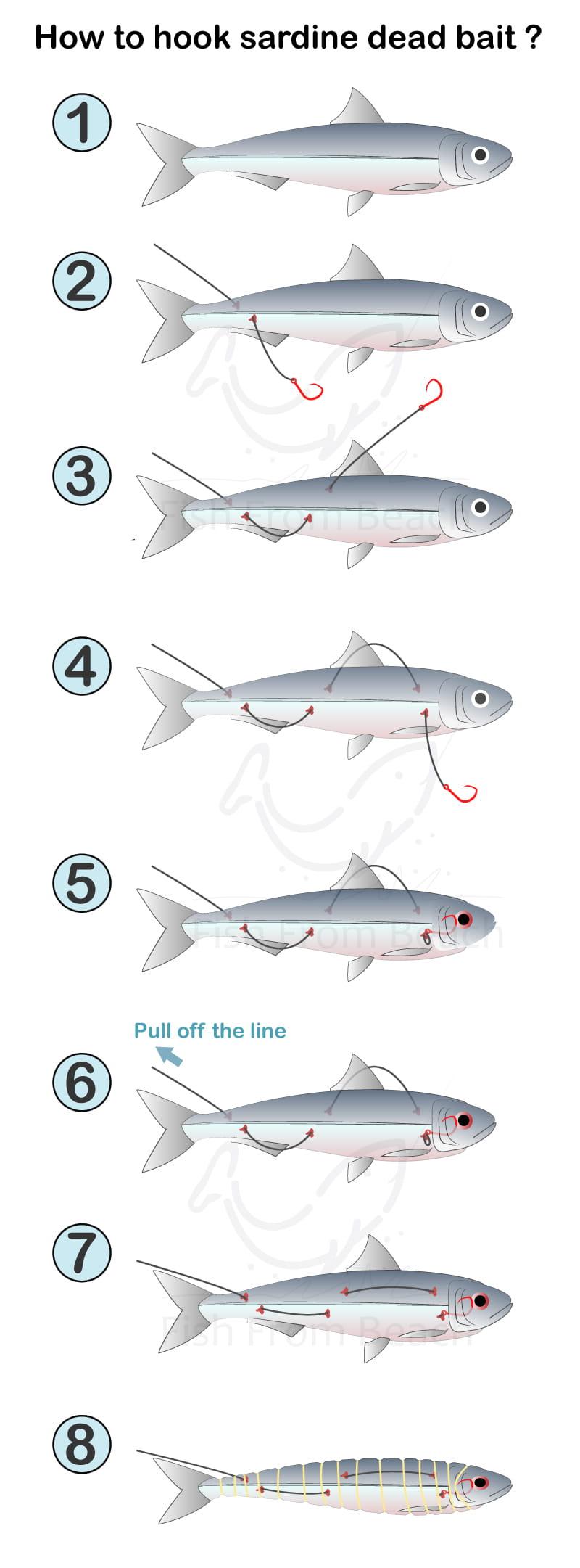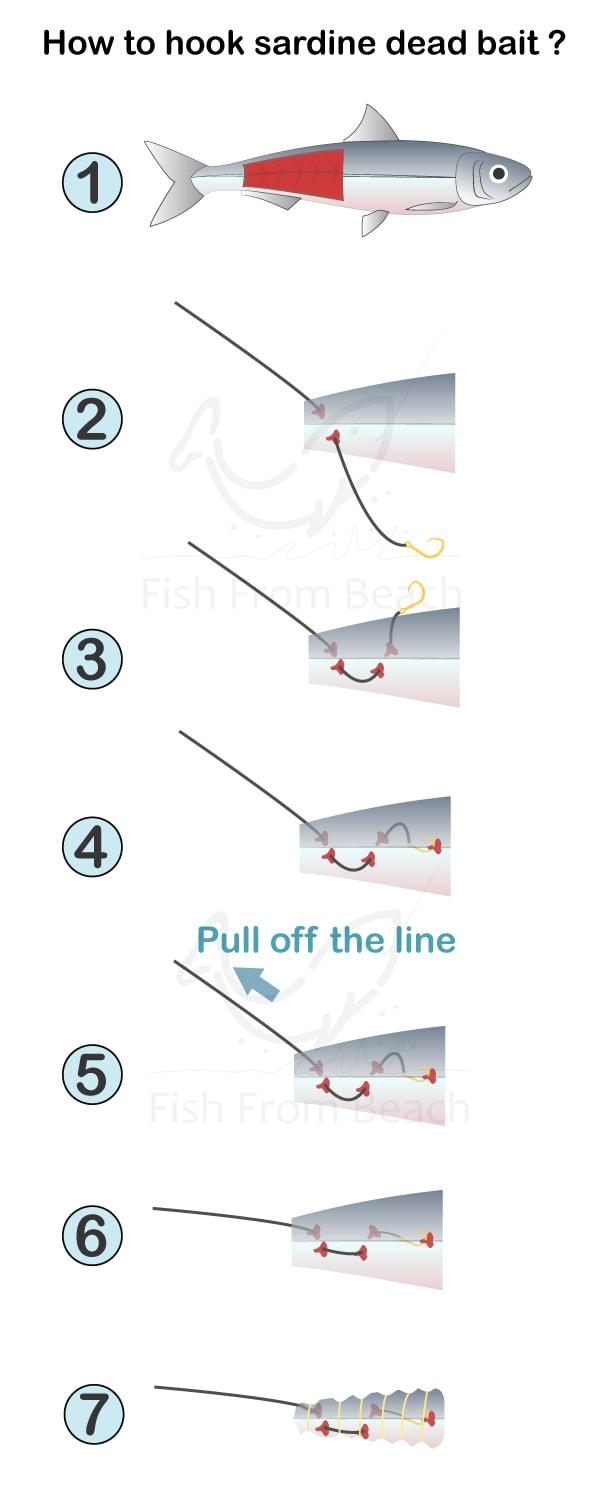
Sardine is known to be one of the most rewarding baits for saltwater fishing. It’s high oil content and the strong smell it releases in the water make it so appealing and so appetizing for hungry predatory fish.
Using sardines as bait will not only improve your hookup ratio but will also introduce you to new species that you are not used to catch using other baits such as shellfish, worms, or minnows.
Personally, when I rig sardines for surf fishing, I experience more bites from rays, dogfish, baby sharks, eel…etc. These species are not so common when I use shrimp, squid, or minnows.
Also, sardine is one of the cheapest baits to acquire.
With a few bucks, you can get 2 pounds of fresh whole sardines. 2 pounds is more than you need for a day of fishing and you will be left with a big quantity to chum with or to freeze for the next fishing trip.
So how to use sardines as bait ? And what is the appropriate way to hook sardine dead bait ?
This is what this article is all about. I want to share with you how I rig sardines for surf or pier fishing, and what you should consider in order to make your sardine bait more appealing, more sticky, and more productive.
NB : The methods I will share in this article can also be used for other baitfish like mackerel, herring, anchovy, pilchard…etc. Use whatever is available in your area and adjust to what works best for you 🙂
The tail method
This is one of the easiest, yet most effective ways to use sardines as bait.
The tail section is the most rigid part of the sardine body. Putting the hook in this section will ensure you have the bait for a longer period of time and will not fly away during the cast.
Choose a sharp knife and cut the tail of a sardine fish. The cut section should measure between 2 and 3 inches. Now use your favorite hook and try to thread the whole tail, side to side. In other words, you need to fully penetrate the tail and not only hook the topmost flesh.
Another thing to remember here is that you have to feel that you are piercing the bone of the fish and not only the flesh. This is the most guaranteed way to keep your bait in the hook during the cast.
That’s all. You are now ready to launch. Simple and easy, right ?
Now there is something I should mention though. With this method, you may feel that the bait is not so stable and that it rotates easily around the hook shank.
That’s true, but don’t worry too much about that.
If you have well pierced the ribs of the fish, you should be okay to get the bait to where you want to be. Losing the bait is most likely to happen if you hook the soft flesh only.

Pros of this method :
- Easy and quick. You don’t need more than 30 seconds to cut the tail and thread it into the hook.
- The tail section is small and receives less friction from air and wind during the cast, allowing you to reach further spots.
- Cut sardines release more oils and scents in the water and therefore attract more fish.
Cons of this method :
- Fish can steal your bait easily without getting caught
- You will need to renew the bait more often
- You may catch a lot of unwanted (small) species. Large fish are not so tempted to sardine tails
The half hitch method
This method consists of cutting half a sardine, just under the dorsal fin, then superficially piercing the flesh of the fish while keeping the point of the hook visible.
Next, make a simple half hitch knot to secure the bait and make it more durable on the hook. to tie the knot, twist the line to create a loop, and then thread the tail into the loop and pull off the line. As simple as that.

Now you may say that sardine is soft and the hook may easily rip off if pierced that shallow.
Well, you are 100% right, but this is the main reason behind using the half hitch knot.
Let me explain…
Since the knot is tied before the hook, it will, therefore, serve as a shock absorber and keep the hook away from pressure. In other words, the knot will be the first thing that receives pressure when you cast the pole, helping to keep your bait well threaded into the hook.
That being said, keep in mind that this bait configuration is still too vulnerable to sudden shakes and when dropped in the water. That’s why I don’t recommend using this method when surf fishing or when trying to cast too far.
I only use this method when fishing from a bridge or a pier and when targeting large species able to eat half a sardine in one strike.
Pros of this method :
- Easy to setup
- Tempting for sizeable fish
- The bait sticks well on the hook as long as you don’t cast too far or too strong
Cons of this method :
- Not for long-distance casting. It will, therefore, be less effective when surf fishing
- Small fish will be able to tug the bait without touching the hook
- You will need to renew the bait more often
The cube chunks method
As the name suggests, use a knife to cut 1-inch, cube-like, chunks of sardine (avoid the head and the tail)
Make sure the knife you are using is sharp and strong. You want the cubes to be knitted and well consolidated so that you can pierce the hook easily and effectively.
I am not a big fan of this method because sardine is too soft and small chunks like these crumble easily when put in the water or during the cast.
That being said, I also believe that this still a great way to use sardines as bait, if you manage to reach the water of course 😀
The biggest advantage of this method is that it keeps the bait small and therefore eatable by small species like pompano, surfperch, snapper, bream…etc.
Moreover, it will be hard for fish to steal your offering without getting caught.
If you like this method and you want to make the bait more sticky on the hook, thread the chunks vertically (through the vertebras) and not horizontally (through the skin). The skin of sardine is slippy and can be challenging to pierce. And again, make sure to keep the point visible.
Pros of this method :
- Cut sardine releases more liquids and scents in the water, and as a result, attracts more fish
- Fish will get caught in one strike. They will rarely manage to steal the food without touching the hook
- Great for small and medium-sized species
- Very effective when pier or rock fishing
Cons of this method :
- Not great for surf fishing
- The bait can fly off easily during the cast or crumble if left too long on the water
- Not so tempting for large fish
- You will need to check the hook more often
The sewing method
This is my favorite method when hooking sardine dead bait.
It’s the only way I go whenever I want to target large fish and keep small species away, and it gives the same success whether I’m fishing from the beach, from a pier, or on a boat. And guess what, It’s not as complicated as it seems.
Tie a hook to your favorite fishing line and then use the hook to make 3 holes, side to side, in the body of a medium-sized sardine, starting from the tail moving up to the head.
Now after you finish this bloody sewing process 😀 pull off the line to make it straight and then use the hook again to connect the eye to the third and last hole you poked, starting from the hole, not the eye. In other terms, you want the hook’s point to come out from the eye, not the hole.
The last thing to do is to use an elastic thread and bind the sardine from the tail up to the head. Make as many wraps you want but don’t cover the hook. You want the hook’s point to stay visible and able to catch things.
I am not sure you are following me here, but the pictures below should be enough to understand the whole process.

If the distance between the third hole and the eye is longer than your hook, don’t worry about it. Squeeze the head of the fish a little and try to reach the eye.
Also, when binding with the elastic thread, don’t bind too tight so you don’t make things messy 😉
As I said before, this is the best configuration to try when you aim for large species like baby sharks, tarpon, red drums, or large bluefish. Small fish will not have the courage to strike a whole sardine, and even if they do, the rubber thread will be there to prevent them from stealing your offering.
Pros of this method :
- So tempting for large and sizeable species
- Very effective at keeping the small and unwanted fish away
- The thread will keep the bait sticky on the hook no matter how powerful your casts are
- The thread will also make the bait more durable and you will not need to renew the offering after every cast
- It gives the same results whether you are fishing from the beach, from a pier/bridge, or from a boat/kayak
Cons of this method :
- It can take some time and skills to set up
- It requires an elastic thread
- Not good for small and medium-sized fish
- Not good for long casting distance. Whole sardines get slowed down by air during the cast
The fillet method
This is quite similar to the previous method, except that you don’t sew the whole fish, but just a small fillet of its body flesh.
To make the fillet, take a sharp knife and start cutting the sardine vertically, just under the dorsal fin, and keep cutting until you reach the bones. When you feel the vertebrae, go horizontally towards the tail until you have a 2-3 inch fillet.
Now with this fillet in hand, repeat the same sewing process of the previous method and at the third hole, you don’t need to pull the entire hook out, only pierce the fillet and keep the hook there with the point visible.
And similarly, pull off the line and use an elastic thread to wrap the fillet and make it more sticky on the hook.

This is by far the best method to follow when using sardines as bait, especially If you are fishing just for fun and not targeting a specific size or species.
Sardines hooked this way will be attractive for both small and large species, and the rubber thread will make your offering more sticky, more durable, and fish will not be able to steal food without getting caught.
On top of that, fillets of sardine release more oils and odors in the water helping to draw the attention of predatory fish.
Pros of this method :
- The bait remains longer on the hook and you don’t need to check the hook so often
- Attractive for both large and small species
- Cutting sardines releases oils and liquids in the water helping to attract fish
- Good for long-distance casting because the thread shrinks the bait and makes it more aerodynamic
- Effective for all sorts of fishing
Cons of this method :
- It can take some time and skills to set up
- It requires an elastic thread
The eye method
The last method I want to share with you today is the eye method.
I’m sure that you have already hooked, or seen others hooking whole minnows or pinfish through their eye. Well, you can do the same with whole sardines too.
The eye contour is a firm and solid area in the body of most fish. Therefore, when you hook fish in their eye, you make sure that the bait will stay on the hook for a longer period of time and will not fly away easily.
With this in mind, I should also mention that this method is more effective with small fish such as minnows, bluegill, pinfish… etc. With larger species like sardines, herring, or mackerel, there is a good chance that fish will steal your bait without getting caught.
I only recommend this method when you know that large predatory fish are within your casting range.
Small and medium-sized species will be hard to catch with eye-hooked sardines as they may only tug on the bait and steal small chunks of food.
As a general rule, you should expect more success hooking sardines this way if you are on a boat or a kayak, or when fishing from a bridge or a pier. Shore anglers should consider other methods.

Pros of this method :
- The bait will remain longer on the hook
- Attractive for large species
- Dead sardine may look like a wounded live fish. Nothing more appetizing for hungry predators
Cons of this method :
- Fish can take the food without touching the hook
- Not for long-distance casting. Whole sardines receive more friction from air during the cast and therefore fail to go too far
- Small species may only tug on the bait and never get caught
Few tips when using sardines as bait
If you can get sardines a day before fishing, put them in a large bowl and cover them with a large amount of table salt (8-10 oz). Leave them this way in the fridge for the whole night.
If you have a large amount of sardines, divide it into 2 layers and put salt between the layers too. The salt will make the sardine firmer and you will be able to hook it much more easily.
Bait holder hooks are the best hooks when baiting with sardines because, as the name suggests, they help to keep the bait on the hook. Circle hooks are also great for sardine dead bait.
If you have a large amount of sardines, more than you will need for the day, cut some sardines into 1-inch chunks, and try to chum the area where you plan to cast the bait.
Only use fresh sardine for bait. The fresher your sardines, the more bites you will have.
Some recommended bait-related gear (*)
Note (*): If you make a purchase through links from this website, we may get a small share of the sale from Amazon or other similar affiliate programs.
Surf Fishing Survey
Help us provide you with better content by answering simple questions about your surf fishing experience and knowledge.
We will put the collected responses together and turn them into valuable information that will help you catch more fish from shore 😉
Note: No personal information will be collected with your answer.

